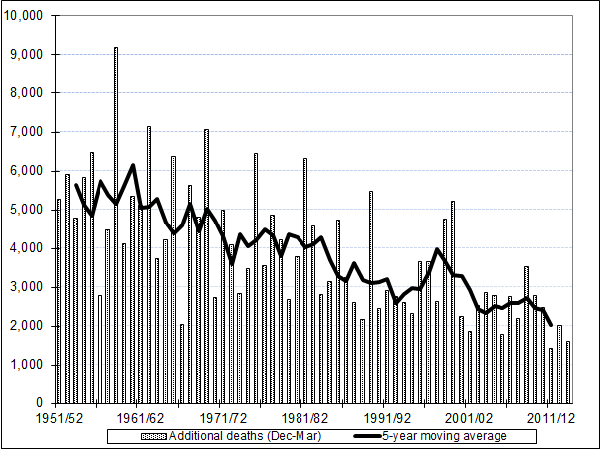The number of deaths registered in Scotland during winter 2013/14 was the lowest since records began more than 60 years ago.
Figures released today by the National Records of Scotland (NRS) show there were 18,675 deaths registered in Scotland in the four months to March 2014. This was the lowest number of deaths registered in Scotland in the winter since records began in 1951/52.
The 18,675 deaths registered in the four winter months of 2013/14 exceeded both the 16,848 deaths in the preceding four-month period and the 17,297 deaths in the following four-month period.
The seasonal difference (comparing the four winter months with the average of the four-month periods before and after the winter, and rounding the result) was 1,600 for winter 2013/14. This was about 400 below the corresponding figure of 2,000 for winter 2012/13, and the second lowest figure of any of the 63 winters for which these statistics have been produced (the 1,420 for winter 2011/12 was the lowest value). The last fourteen winters have had seven out of the ten lowest figures in the 63 winters for which these statistics are available.
Commenting on ‘Winter Mortality in Scotland - 2013/14’, Tim Ellis, Chief Executive of the National Records of Scotland, said:
"There are always more deaths in the winter in Scotland than in any other season, but last winter had the second lowest seasonal increase in all the years, since 1951/52, for which we have figures.
"The long-term trend over the last 60 years or so has clearly been downward. The five-year moving average, which smoothes out much of the year-to-year fluctuation, is at its lowest ever level.
"There is no single cause of additional deaths in winter. Very few are caused by hypothermia and only a small proportion by influenza. Most are from respiratory and circulatory diseases such as pneumonia, coronary heart disease and stroke.”
Seasonal Increase in Mortality in the Winter, Scotland, 1951/52 to 2013/14

The full publication ‘Winter Mortality in Scotland 2013/14’ is available on the NRS website.